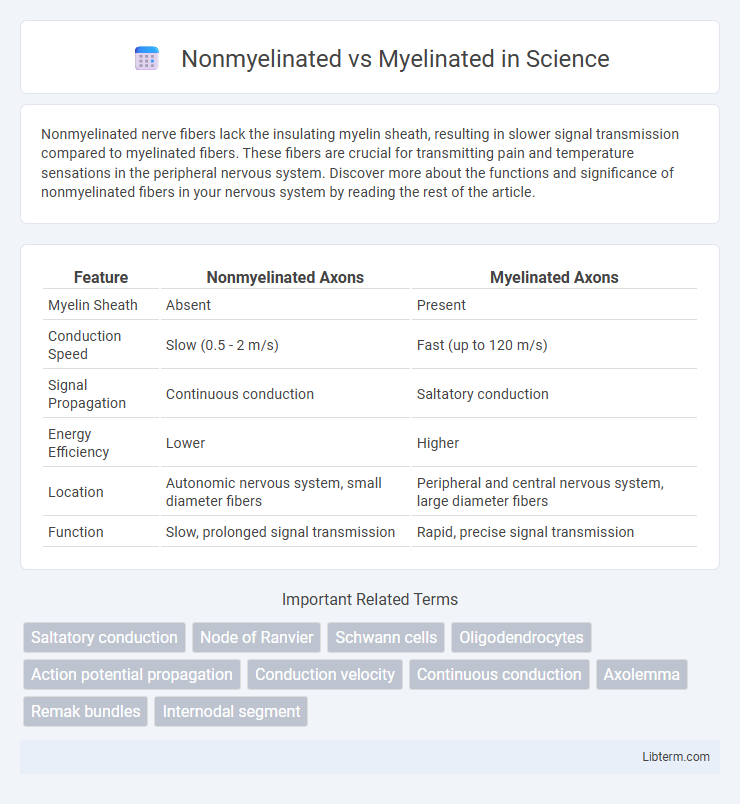Nonmyelinated nerve fibers lack the insulating myelin sheath, resulting in slower signal transmission compared to myelinated fibers. These fibers are crucial for transmitting pain and temperature sensations in the peripheral nervous system. Discover more about the functions and significance of nonmyelinated fibers in your nervous system by reading the rest of the article.
Table of Comparison
| Feature | Nonmyelinated Axons | Myelinated Axons |
|---|---|---|
| Myelin Sheath | Absent | Present |
| Conduction Speed | Slow (0.5 - 2 m/s) | Fast (up to 120 m/s) |
| Signal Propagation | Continuous conduction | Saltatory conduction |
| Energy Efficiency | Lower | Higher |
| Location | Autonomic nervous system, small diameter fibers | Peripheral and central nervous system, large diameter fibers |
| Function | Slow, prolonged signal transmission | Rapid, precise signal transmission |
Introduction to Neuronal Fibers
Neuronal fibers are classified into nonmyelinated and myelinated types based on the presence of a myelin sheath, which significantly affects nerve signal transmission speed. Myelinated fibers contain an insulating layer of myelin produced by Schwann cells or oligodendrocytes, enabling rapid, saltatory conduction along the axon. In contrast, nonmyelinated fibers lack this sheath, resulting in slower continuous conduction but offering metabolic efficiency and increased resistance to injury in certain nervous system regions.
What Are Nonmyelinated Nerve Fibers?
Nonmyelinated nerve fibers are axons lacking a myelin sheath, resulting in slower nerve signal transmission compared to myelinated fibers, which are insulated by myelin. These fibers primarily facilitate autonomic functions and pain transmission, found abundantly in the peripheral nervous system. Their unmyelinated state allows for continuous conduction, essential for sustained signaling in certain physiological processes.
What Are Myelinated Nerve Fibers?
Myelinated nerve fibers are axons surrounded by a multilayered lipid-rich myelin sheath produced by glial cells such as Schwann cells in the peripheral nervous system and oligodendrocytes in the central nervous system. This myelin sheath acts as an electrical insulator, significantly increasing the speed of action potential conduction through saltatory conduction along nodes of Ranvier. Myelinated fibers are essential for rapid signal transmission in motor and sensory pathways, contrasting with nonmyelinated fibers that conduct impulses more slowly due to continuous propagation.
Structural Differences: Nonmyelinated vs Myelinated
Nonmyelinated axons lack the insulating myelin sheath, resulting in slower nerve impulse conduction compared to myelinated fibers, which are wrapped by multiple layers of myelin produced by Schwann cells in the peripheral nervous system or oligodendrocytes in the central nervous system. The presence of nodes of Ranvier in myelinated axons facilitates saltatory conduction, allowing rapid action potential propagation, whereas nonmyelinated axons conduct signals through continuous wave-like depolarization. Structurally, myelinated axons have a larger diameter and distinct layers of lipid-rich myelin that increase membrane resistance and decrease capacitance, optimizing speed and efficiency of neural communication.
Conduction Speed and Efficiency
Myelinated axons conduct nerve impulses significantly faster than nonmyelinated axons due to the presence of the myelin sheath, which enables saltatory conduction by allowing action potentials to jump between nodes of Ranvier. Nonmyelinated axons rely on continuous conduction along the entire membrane, resulting in slower signal transmission and greater energy consumption. The insulation provided by myelin not only enhances conduction speed but also improves efficiency by reducing ion leakage and the metabolic demand required for maintaining the action potential.
Energy Consumption in Signal Transmission
Myelinated axons significantly reduce energy consumption during signal transmission by facilitating saltatory conduction, which allows action potentials to leap between nodes of Ranvier, minimizing ion exchange and ATP usage. In contrast, nonmyelinated axons require continuous propagation of action potentials along the entire membrane, leading to higher metabolic demand due to increased activity of Na+/K+ ATPase pumps to restore ionic gradients. This energy efficiency provided by myelination is crucial for rapid and sustained neural signaling in vertebrate nervous systems.
Distribution in the Nervous System
Nonmyelinated fibers predominantly occur in the peripheral nervous system, especially within autonomic nerves regulating involuntary functions, and are abundant in the gray matter of the central nervous system where slower signal transmission suffices. Myelinated fibers are extensively distributed in both the central and peripheral nervous systems, forming critical pathways such as the corticospinal tracts and large sensory nerves, enabling rapid and efficient impulse conduction. The differential distribution supports functional specialization, with myelination facilitating high-speed communication in motor and sensory systems and nonmyelinated fibers accommodating slower, modulatory signals.
Functional Roles and Specializations
Nonmyelinated nerve fibers primarily support slow, continuous signal transmission suited for pain and temperature sensations, enabling prolonged, diffuse signaling across the peripheral nervous system. Myelinated fibers specialize in rapid and precise signal conduction through saltatory transmission, facilitating quick motor responses and complex sensory processing essential for reflexes and fine motor control. Their structural differences reflect functional adaptations, where myelination enhances conduction velocity and energy efficiency, while nonmyelinated fibers preserve metabolic resources for sustained, slower communication.
Clinical Implications and Disorders
Myelinated nerve fibers enable rapid signal transmission essential for efficient motor and sensory functions, while nonmyelinated fibers conduct signals more slowly, primarily involved in autonomic and pain pathways. Demyelinating disorders like Multiple Sclerosis disrupt myelin sheaths, leading to impaired nerve conduction and diverse neurological symptoms such as muscle weakness, sensory deficits, and cognitive disturbances. Damage to nonmyelinated fibers often results in autonomic dysfunction and altered pain perception, as observed in conditions like diabetic neuropathy and small fiber neuropathy.
Summary: Key Differences and Significance
Nonmyelinated nerve fibers lack the insulating myelin sheath present in myelinated fibers, resulting in slower nerve impulse conduction due to continuous propagation along the axon. Myelinated fibers enable rapid signal transmission through saltatory conduction, where impulses jump between nodes of Ranvier, enhancing neural communication efficiency. This difference is significant in the nervous system's functional organization, with myelinated fibers predominantly facilitating fast motor and sensory signals, while nonmyelinated fibers often transmit slower pain and temperature sensations.
Nonmyelinated Infographic

 libterm.com
libterm.com